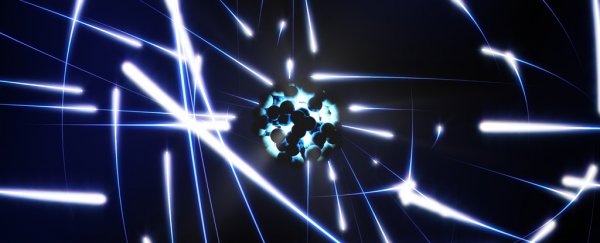Scientists have discovered a new type of uranium that is the lightest ever known. The discovery could reveal more about a weird alpha particle that gets ejected from certain radioactive elements as they decay.
The newfound uranium, called uranium-214, is an isotope, or a variant of the element, with 30 more neutrons than protons, one fewer neutron than the next-lightest known uranium isotope. Because neutrons have mass, uranium-214 is much lighter than more common uranium isotopes, including uranium-235, which is used in nuclear reactors and has 51 extra neutrons.
This newfound isotope isn't just lighter than others, but it also showed unique behaviors during its decay. As such, the new findings will help scientists better understand a radioactive decay process known as alpha decay, in which an atomic nucleus loses a group of two protons and two neutrons - collectively called an alpha particle.
Though scientists know that alpha decay results in the ejection of this alpha particle, after a century of study, they still don't know the exact details of how the alpha particle is formed before it gets ejected.
Related: Elementary, my dear: 8 elements you never heard of
The researchers created the new uranium isotope at the Heavy Ion Research Facility in Lanzhou, China. There, they shone a beam of argon at a target made of tungsten inside a machine called a gas-filled recoil separator - in this case the Spectrometer for Heavy Atoms and Nuclear Structure, or SHANS. By shining a laser at the tungsten, the researchers effectively added protons and neutrons to the material to create uranium.
The new uranium-214 isotope had a half-life of just half a millisecond, meaning that's the amount of time it takes for half of the radioactive sample to decay. The most common isotope of uranium - called uranium-238 - has a half-life of about 4.5 billion years, which is about the age of Earth.
By carefully watching how the isotopes decayed, the scientists were able to study the strong nuclear force - one of the four fundamental forces that hold matter together - acting on the alpha particle parts - the neutrons and protons - on the surface of the uranium.
They found that the proton and neutron in each alpha particle interacted much more strongly than in isotopes and other elements with similar numbers of protons and neutrons that have been previously studied.
This is likely due to the specific number of neutrons inside the nucleus of uranium-214, the researchers said. The new isotope has 122 neutrons, nearing the "magic neutron number" of 126, which is especially stable due to the configuration of the neutrons in complete sets, or shells.
With this configuration, it is easier for scientists to calculate the strong force interaction between the protons and neutrons. That makes these isotopes particularly interesting to scientists, since studying these interactions can reveal features related to nuclear structure and decay process, said study lead author Zhiyuan Zhang, physicist at the Chinese Academy of Sciences.
The scientists suspect that this proton-neutron interaction could be even stronger heavier radioactive elements such as isotopes of plutonium and neptunium. These elements have a few more protons, and the configuration of their orbits suggests they could have even stronger interactions than the uranium isotopes.
The scientists would like to study other elemental isotopes near the magic neutron number; however, since such elements have even shorter half-lives, even more sensitive detectors and more powerful beams will be needed.
The new findings were published April 14 in the journal Physical Review Letters.
Related content:
Nobel prize in chemistry: 1901-present
5 everyday things that are radioactive
8 ways you can see Einstein's theory of relativity in real life
This article was originally published by Live Science. Read the original article here.
